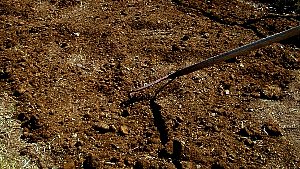|
Gardening Terms-A Gardening Dictionary
Last Frost Date-The last day in Spring that has had frost averaged over a number of years. First Frost Date-The first day in fall that has had frost averaged over a number of years. Days to germination-The number of days required by a specific plant's seed to go from planting to sprouting and emerging from soil at a soil temperature of about 68-70 degrees. Days to harvest-The number of days from germination to ready to eat status of a given crop. Lettuce is a matter of size, fruiting plants like eggplant have fruit that needs to ripen before picking. Climate Zone-The zone is the description of what the climate and frost dates indicate for plant growth in a particular area. It is affected by latitude, elevation, humidity, and rainfall. Soil PH-The chemical acidity or alkalinity of soil. The soil is measured by variation from Neutral, which is 7.0. If soil is lower than 7.0 it is acid, if it is higher, then it is alkaline soil. Most plants grow best in a ph between 6.0 and 7.5, with 6.0-6.5 being ideal.
Components of Soil:Garden soil-the natural medium for growing plants. Composed of varying amounts of sand, clay, silt, and organic matter. Organic matter-bits of leaves, bark, stems and roots of plants in varying stages of decay. Usually accumulates over time by leaves and dying plants, and converted into humus by insects and bacteria in the soil. Humus-the dark brown/black particles that originated from plant and animal wastes and give nutrition and body to the soil. It is the end stage of breakdown of organic matter. Clay-small very dense particles that bind closely together and prevent the passage of air and water. Sand-large particles that freely and quickly allow the passage of air and water. Silt-the very fine particles resulting from breakdown of rocks and minerals. Planting medium-often soil, but may be a soil-less mix usually composed of large particles of perlite or vermiculum, bark, and peat moss.
Soil Amendments:Compost-the result of the breakdown of organic matter into humus. Mulch-any matter that can insulate the soil from water loss and temperature variations. Examples would be pine needles, pine bark, straw, forest debris, leaves, and even newspaper. Used as a top dressing to insulate a planting site from these issues. Steer manure-the products of waste produced by cattle, usually available sterilized from garden centers. Also available raw from farms and dairies. Sterilized is best to prevent weed seeds and possible bacterial contamination. Can be very hot and burn plants in excess quantities. A little goes a long way, helps amend and fertilize soil. Dolomite lime-ground limestone that is added to acid soil to raise the ph of the soil to between 6 and 7.5. Gypsum-a form of calcium that when added to clay soils can help improve soil structure and remove sodium (salts) from soils that have much salt, like coastal and alkaline clay soil. Should not be used on acid soils. Soil sulfur-soil amendment that will improve soil ph and make many nutrients more available to plants. Ammonia sulfate-soil amendment that helps to lower the ph and increase the availability of nutients in poor soil by adding sulfur. Microbes-bacteria and fungi that break down organic matter and assist in the transport of nutrients and water to plant roots.
from Gardening Terms back to Beginner Gardening from Gardening Terms back to Vegetable Gardening Advice Home Page |






